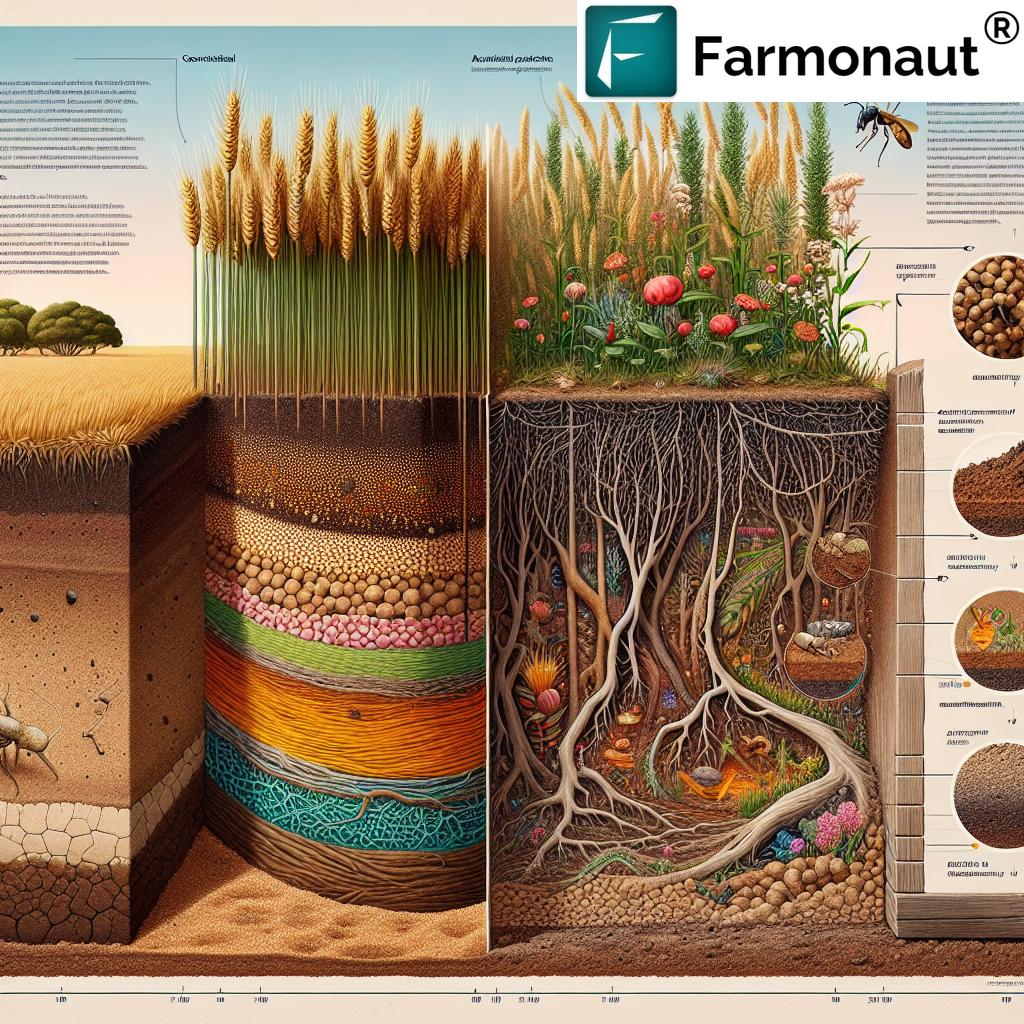Revolutionizing Australian Agriculture: Innovative Soil Health Practices for Climate-Resilient Farming Systems

“Dung beetles, as ecosystem engineers, can improve soil nutrient cycling by up to 30% in agricultural systems.”
In the ever-evolving landscape of Australian agriculture, we find ourselves at the forefront of a revolution in soil health practices and climate-resilient farming systems. As we delve into the insights from the “Talkin’ Soil Health 2022” conference, we’ll explore cutting-edge techniques and technologies that are transforming the way we approach farming in the face of climate change. From the bustling microbial world beneath our feet to the innovative use of satellite technology, we’re uncovering new pathways to sustainable and productive agriculture.
At Farmonaut, we’re committed to supporting these advancements with our precision agriculture tools, helping farmers implement data-driven solutions for improved soil health, increased productivity, and environmental stewardship. Let’s embark on this journey to discover how we can revolutionize Australian agriculture together.
The Foundation of Soil Health: Microbial Indicators
Soil health is the cornerstone of sustainable agriculture, and microbial indicators play a crucial role in assessing and improving it. Recent research from the University of Western Australia and other leading institutions has shed light on the importance of soil microorganisms in maintaining healthy, productive farmland.
- Microbial Diversity: A rich and diverse microbial community in the soil is essential for nutrient cycling, organic matter decomposition, and disease suppression.
- Enzyme Activity: Soil enzymes, produced by microorganisms, are key indicators of biological activity and nutrient availability.
- Mycorrhizal Fungi: These symbiotic fungi form associations with plant roots, enhancing nutrient uptake and water efficiency.
By monitoring these microbial indicators, farmers can gain valuable insights into their soil’s health and make informed decisions about management practices. Farmonaut’s satellite-based crop health monitoring system complements these ground-level assessments by providing a broader view of vegetation health through NDVI (Normalized Difference Vegetation Index) analysis.
Carbon Farming: A Win-Win for Climate and Crops
Carbon farming techniques are gaining traction across Australia as a means to combat climate change while improving soil fertility. These practices focus on increasing soil organic carbon (SOC) content, which not only sequesters atmospheric carbon but also enhances soil structure, water retention, and nutrient availability.
- Cover Cropping: Planting cover crops during fallow periods protects the soil and adds organic matter.
- Reduced Tillage: Minimizing soil disturbance helps preserve soil structure and retain carbon.
- Crop Rotation: Diversifying crops improves soil health and breaks pest cycles.
Farmonaut’s AI-powered advisory system, Jeevn AI, can assist farmers in implementing these carbon farming techniques by providing personalized recommendations based on satellite data and local conditions.
The Unsung Heroes: Ants, Termites, and Dung Beetles
In the arid and semi-arid regions of Australia, some unexpected allies are playing a crucial role in maintaining soil health and agricultural productivity. Ants, termites, and dung beetles are emerging as important ecosystem engineers, contributing significantly to soil structure and nutrient cycling.
- Ants and Termites: These insects create complex tunnel networks that improve soil aeration and water infiltration, particularly beneficial in sandy soils of Western Australia’s Wheatbelt region.
- Dung Beetles: By burying and processing animal dung, these beetles enhance nutrient distribution and soil organic matter content.
Research from the University of Sydney and international collaborators in Germany, Singapore, and Japan has highlighted the importance of these organisms in maintaining soil health, especially in challenging climates. Farmonaut’s satellite imagery can help farmers identify areas where these beneficial insects are thriving by detecting patterns in vegetation health and soil moisture.
Perennial Pasture Management: Building Resilience in Livestock Systems
Perennial pastures are gaining recognition as a powerful tool for building climate-resilient farming systems, particularly in mixed crop-livestock operations. These deep-rooted plants offer numerous benefits:
- Soil Stabilization: Perennial root systems prevent erosion and improve soil structure.
- Carbon Sequestration: Long-lived plants store more carbon in soil over time.
- Drought Tolerance: Deep roots access water and nutrients unavailable to annual crops.
Managers of perennial pastures can benefit from Farmonaut’s fleet and resource management tools to optimize grazing rotations and monitor pasture health across large areas.
“Perennial pastures can increase soil carbon sequestration by 0.5-1.0 tons per hectare annually in climate-resilient farming systems.”
Drought Management: Strategies for South-West Australia
The South-West region of Australia faces unique challenges when it comes to drought management. Climate change is exacerbating these challenges, making it crucial for farmers to adopt innovative strategies:
- Precision Irrigation: Using Farmonaut’s soil moisture monitoring to optimize water use efficiency.
- Drought-Tolerant Crop Varieties: Selecting plants bred for resilience in dry conditions.
- Soil Water Conservation: Implementing practices like mulching and contour plowing to retain moisture.
Farmonaut’s weather forecasting capabilities, integrated with our satellite data, provide farmers with valuable insights for drought preparedness and response.
Building Natural Capital in Agriculture
The concept of natural capital is gaining traction in Australian agriculture, recognizing the economic value of ecosystem services provided by healthy soils, biodiversity, and sustainable farming practices. Key aspects include:
- Biodiversity Conservation: Preserving native vegetation and wildlife habitats on farmland.
- Ecosystem Services Valuation: Quantifying the economic benefits of pollination, pest control, and water purification provided by natural systems.
- Sustainable Resource Management: Balancing productivity with long-term ecological health.
Farmonaut’s carbon footprinting feature can help farmers track and quantify their contributions to natural capital, supporting sustainable management practices and potentially opening up new revenue streams through carbon credits or ecosystem service payments.
Explore Farmonaut’s API for advanced data integration
Innovative Agricultural Technology Integration
The integration of cutting-edge technology is revolutionizing Australian agriculture, enabling more precise, efficient, and sustainable farming practices. Some key technological advancements include:
- Remote Sensing: Satellite and drone imagery for crop health monitoring and yield prediction.
- IoT Sensors: Real-time data collection on soil moisture, temperature, and nutrient levels.
- AI and Machine Learning: Advanced analytics for personalized crop management recommendations.
Farmonaut is at the forefront of this technological revolution, offering a comprehensive suite of tools that leverage satellite imagery, AI, and blockchain technology to support sustainable and productive farming practices.
Adapting to Climate Change: Research-Driven Solutions
As climate change continues to impact Australian agriculture, research institutions across the country are developing innovative solutions to help farmers adapt:
- Heat-Tolerant Crop Varieties: Breeding programs at universities and research centers are developing crops that can withstand higher temperatures and more frequent heatwaves.
- Water-Efficient Farming Systems: Research into deficit irrigation and water-saving technologies is helping farmers produce more with less water.
- Climate-Smart Agriculture: Integrated approaches that combine climate adaptation with mitigation strategies, such as agroforestry and conservation agriculture.
Farmonaut’s platform can assist in implementing these research-driven solutions by providing real-time data on crop health, soil moisture, and weather patterns, enabling farmers to make informed decisions in the face of changing climate conditions.
The Role of Compost and Organic Matter in Soil Health
Compost and organic matter play a crucial role in maintaining and improving soil health, particularly in the sandy soils common in many parts of Australia. The benefits of incorporating these materials include:
- Improved Soil Structure: Organic matter helps bind soil particles, reducing erosion and improving water retention.
- Enhanced Nutrient Availability: Compost slowly releases nutrients, providing a steady supply to plants.
- Increased Microbial Activity: Organic matter supports diverse soil microbiomes, crucial for nutrient cycling and plant health.
Farmonaut’s vegetation index analysis can help farmers track the impact of compost applications on crop health and soil productivity over time.
Sustainable Herbicide Management in Australian Agriculture
Herbicide management is a critical aspect of modern farming, but it must be balanced with environmental concerns and the need for long-term sustainability. Key strategies include:
- Integrated Weed Management: Combining chemical controls with cultural and mechanical methods to reduce herbicide dependence.
- Precision Application: Using GPS-guided sprayers and variable rate technology to minimize herbicide use.
- Cover Cropping: Suppressing weeds naturally through competition and allelopathy.
Farmonaut’s crop health monitoring can assist in identifying areas of weed pressure, allowing for targeted and efficient herbicide application.
Crop Residue Management for Soil Health
Proper management of crop residues is essential for maintaining soil health and productivity in Australian farming systems. Benefits include:
- Erosion Control: Residues protect the soil surface from wind and water erosion.
- Moisture Conservation: Surface residues reduce evaporation and increase water infiltration.
- Nutrient Cycling: Decomposing residues release nutrients back into the soil.
Farmonaut’s satellite imagery can help farmers assess residue cover and its impact on soil moisture and crop health, informing decisions on tillage practices and residue management strategies.
Soil Health Indicators and Their Benefits for Australian Agriculture
| Soil Health Indicator | Benefits to Soil Health | Impact on Crop Yield | Climate Resilience Factor (1-5) | Farmonaut Tool Application |
|---|---|---|---|---|
| Microbial Activity | Improved nutrient cycling, disease suppression | 10-15% increase | 4 | Vegetation index analysis |
| Soil Organic Carbon | Enhanced water retention, soil structure | 5-10% increase | 5 | Carbon footprint tracking |
| Ant/Termite Presence | Improved soil aeration, water infiltration | 3-7% increase | 3 | Soil moisture monitoring |
| Dung Beetle Activity | Enhanced nutrient distribution, organic matter incorporation | 5-8% increase | 3 | Vegetation health monitoring |
| Perennial Pasture Cover | Increased carbon sequestration, soil stabilization | 8-12% increase (in mixed systems) | 4 | Fleet and resource management |
Conclusion: Embracing Innovation for a Sustainable Future
As we’ve explored throughout this comprehensive overview, the future of Australian agriculture lies in embracing innovative soil health practices and climate-resilient farming systems. From harnessing the power of soil microorganisms to leveraging cutting-edge technology, farmers have a wealth of tools and strategies at their disposal to improve productivity while safeguarding the environment.
Farmonaut is proud to be at the forefront of this agricultural revolution, providing farmers with the data-driven insights and precision agriculture tools needed to implement these sustainable practices effectively. By combining traditional farming wisdom with advanced technology, we can create a more resilient, productive, and sustainable agricultural sector in Australia and beyond.
As we face the challenges of climate change and increasing global food demand, let’s work together to revolutionize Australian agriculture, one healthy soil at a time.

Frequently Asked Questions
- What are the key soil health indicators for Australian farms?
Key soil health indicators include microbial activity, organic carbon content, soil structure, water infiltration rate, and nutrient availability. These can be assessed through soil tests and visual observations. - How can farmers implement carbon farming techniques?
Farmers can implement carbon farming techniques by adopting practices such as minimal tillage, cover cropping, crop rotation, and incorporating organic matter into the soil. These practices help increase soil organic carbon content. - What role do ants and termites play in soil health?
Ants and termites act as ecosystem engineers, creating tunnels that improve soil aeration and water infiltration. This is particularly beneficial in arid and semi-arid regions with sandy soils. - How can perennial pastures improve farm resilience?
Perennial pastures enhance farm resilience by improving soil structure, increasing carbon sequestration, providing year-round ground cover, and offering drought tolerance due to their deep root systems. - What are some effective drought management strategies for Australian farmers?
Effective drought management strategies include implementing precision irrigation, selecting drought-tolerant crop varieties, practicing soil moisture conservation techniques, and utilizing weather forecasting tools for proactive planning.






